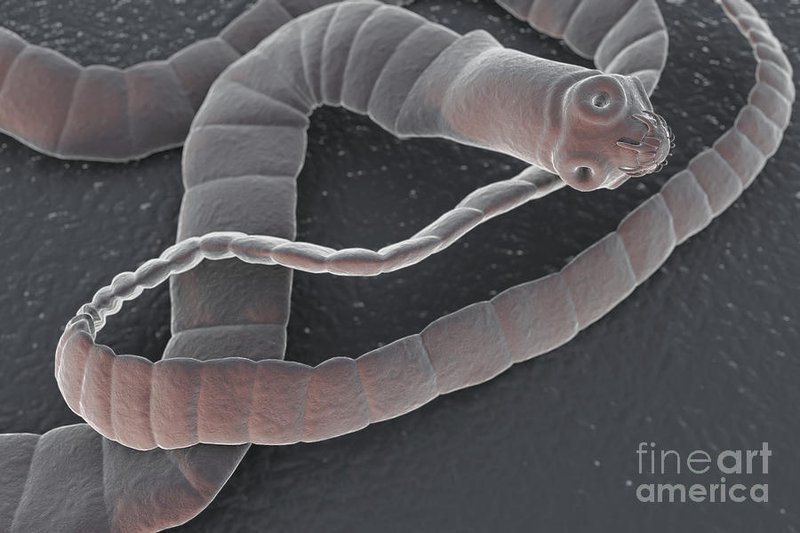
These creatures can stretch up to several feet long, and their body is made of segments called proglottids. It’s almost like a necklace made of a row of beads, each bead capable of producing eggs. You might be wondering how they get there in the first place. Their life cycle involves multiple hosts and is quite the journey, akin to a bizarre relay race. From ingestion of contaminated food to their eventual maturation in the intestines, each stage contributes to the tapeworm’s fascinating life story.
What Exactly Is a Tapeworm?
To put it simply, a tapeworm is a type of flatworm that belongs to the class Cestoda. These parasites are typically found in the intestines of their hosts. Imagine them as long, ribbon-like creatures that silently absorb nutrients while you go about your day. Unlike other worms, they don’t have a mouth or digestive system. Instead, they cling to the intestinal walls and soak up whatever nutrients their host consumes. This means they can survive by simply being along for the ride.
Tapeworms come in various species, but only a few are known to infect humans, such as *Taenia saginata* (the beef tapeworm) and *Taenia solium* (the pork tapeworm). They can be quite resilient, surviving for years inside a host. While they might sound unpleasant, they play a role in ecosystems, helping to regulate host populations and, in some cases, serving as indicators of environmental health.
How Do Tapeworms Get Into Their Hosts?
You might be surprised to learn how these little critters make their way into unsuspecting hosts. The transmission of tapeworms typically occurs through the consumption of contaminated food or water. For example, if you eat undercooked or raw meat that carries the larvae of a tapeworm, you’re in danger of hosting one. It’s like inviting a party crasher who sneaks in without an invitation!
Here’s a step-by-step breakdown of how this happens:
- Ingestion: The host accidentally consumes tapeworm eggs or larvae found in contaminated food or water.
- Development: Inside the intestines, the larvae mature into adult tapeworms. This process can take just a few weeks.
- Reproduction: Once mature, they produce proglottids, which contain thousands of eggs.
- Excretion: These segments are then shed in the host’s feces, potentially infecting new hosts through environmental contamination.
So, keeping proper hygiene and cooking meat thoroughly is key to preventing these unwanted guests from crashing your intestinal party.
Symptoms of Tapeworm Infection
Now that we know how tapeworms get in, let’s talk about what happens when they do. You might think a tapeworm infection would come with a clear warning sign, like a flashing light. However, many people experience mild or even no symptoms at all. It’s like having a pesky roommate who makes little messes but isn’t loud enough to be bothersome.
When symptoms do occur, they can vary, including:
- Abdominal pain: This can feel like a dull ache or cramping.
- Weight loss: Since the tapeworm absorbs nutrients, hosts may find themselves losing weight despite normal eating habits.
- Nausea: Some individuals report feeling nauseous or having a reduced appetite.
In more severe cases, you might notice segments of the tapeworm in your stool. This can be alarming, but it’s crucial to seek medical attention if you suspect an infection.
How Are Tapeworms Diagnosed?
Diagnosing a tapeworm infection involves a few steps, much like solving a mystery. The first clue often comes from your symptoms. If you go to the doctor suspecting you have a tapeworm, they may ask about your dietary habits—did you recently indulge in undercooked meat?
To confirm the presence of a tapeworm, doctors typically use one or more of these methods:
- Stool sample: The most common method is checking for tapeworm eggs or segments in a stool sample.
- Blood test: This may help identify antibodies against specific types of tapeworms.
- Imaging tests: In some cases, doctors might use ultrasound or CT scans to visualize tapeworms, especially if they suspect complications.
Once diagnosed, treatment can begin, generally involving medication to help rid the body of the infection.
Treatment Options for Tapeworms
If you find yourself hosting a tapeworm, don’t worry. Treatments are usually effective and straightforward. The first line of defense is often a prescription medication, commonly called anti-parasitic drugs. These medications essentially starve the tapeworm or cause it to detach from the intestinal wall.
Here’s what you might expect during treatment:
- Medication: Commonly prescribed medications include praziquantel or niclosamide.
- Follow-up: After treatment, you may need a follow-up stool test to ensure the tapeworm has been eliminated.
- Monitoring symptoms: Keep an eye on any lingering symptoms to ensure there aren’t complications.
Most people see improvements within a few days, but it’s essential to follow your doctor’s advice for a complete recovery.
Prevention Is Key
Like many health issues, *prevention* is always better than cure. To keep tapeworms at bay, here’s what you can do:
- Cook food thoroughly: Make sure to cook meat to safe temperatures to kill potential tapeworm larvae.
- Wash hands: Good hygiene is crucial, especially after using the bathroom or handling food.
- Avoid contaminated water: Drinking untreated water or eating food from dubious sources can increase your risk.
These simple precautions are like putting a lock on your door; they keep those uninvited guests out!
Tapeworms are intriguing little creatures that remind us of the complex relationships between hosts and parasites. While they may seem strange and unsettling, understanding how they operate can empower us to take action against them. By being aware of how we can get infected, spotting symptoms early, and taking preventive measures, we can keep our bodies free from these unwanted guests.
Just remember, if you ever suspect you have a tapeworm, don’t hesitate to reach out to a healthcare provider. After all, it’s always better to address health concerns head-on rather than wait for a “tapeworm party” to spiral out of control! Stay curious, stay informed, and keep your gut happy!

